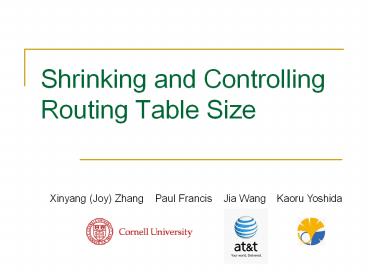Shrinking and Controlling Routing Table Size PowerPoint PPT Presentation
Title: Shrinking and Controlling Routing Table Size
1
Shrinking and Controlling Routing Table Size
Xinyang (Joy) Zhang Paul Francis Jia Wang
Kaoru Yoshida
2
Outline
- We have a trick for making routing tables very
small - Global IP, VPNs
- Called CRIO (Core-Router Integrated Overlay)
3
1977
- Folks were looking at the basic trade-off between
routing table size and path length
4
1977
- Folks were looking at the basic trade-off between
routing table size and path length
5
1977
- Folks were looking at the basic trade-off between
routing table size and path length
6
Path-length / Table size trade-off
- A nice trade-off to have
- This trade-off doesnt exist today
- Hierarchical nature of internet forces an
ISP-centric address assignment model - Because of multi-homing, sites dont fit neatly
into a single cloud
7
CRIO has two parts
- Mapping/tunneling part
- Can operate stand-alone
- Virtual prefix part
- Requires mapping/tunneling
8
Mapping/tunneling part
- BGP keeps routes to major POPs only
- 1000 2000 of these
- One prefix per POP
- Separate mapping table binds customer prefixes to
POPs (ETR address in POP) - Forwarding is two-step
- Map address to ETR
- Tunnel packet to ETR address
- Not a new idea
- Deerings Map-N-Encap, Kim Claffy et. al.
9
Distributed route computation vs. Data
distribution
- Shifts work from distributed route computation
problem to data distribution problem - Easier to debug
- Mapping table is the same everywhere, BGP RIBs
are not - Easier to secure
- Secure mapping only, not entire path
- Streamlined BGP can converge faster
- A small number of very stable prefixes
- Operators could crank down the timers
10
Mapping Distribution
- One possibility (in original CRIO)
- Handling by mapping agents (boxes separate from
routers) - OSPF-like flooding across agent overlay
- Alternatives
- Handling by routers, using BGP (Atomized Routing)
- Handling by routers, using ICMP-like notification
(LISP)
11
Mapping Dynamics (using agents)
Agent
mapping ltprefix, ETR1gt invalid (via flooding)
Agent
ISP2
ISP1
prefix withdrawn (via IBGP)
ITR
Selectively install
ETR1
X
CE
ETR2
12
Other mapping characteristics
- Provides a new policy hook
- For multi-homed nodes, mapping can indicate
access preference - Tunneling Mechanisms
- One-ended TE accepts tunnels packets regardless
of where they came from. IP/IP - Mapping Authentication
13
Mapping doesnt shrink FIB per se
- Mapping appears as FIB entries
- FIB might become larger
- fine-grained multi-homing
- Use Virtual Prefix to shrink the FIB size
14
Virtual Prefixes an Illustration
- Mappings for a given virtual super-prefix are
stored only at selected routers - These routers advertise the virtual prefix into
BGP
Prefix TE Source
Virtual Prefix Adv. 24.0.0.0/8
ETR ---- BGP
24.1.1.0/24 ETR Mapping
ITR2
24.1.1.1
ETR
ETR
24.1.1.1
24.1.1.0/24
24.1.1.1
Customer Site
ITR1
CE2
Prefix TE Source
ETR ---- BGP
ITR2 ---- BGP
24.1.1.0/24 ETR Mapping
24.0.0.0/8 ---- BGP
15
Virtual Prefixes
- Mapping tables and FIBs are smaller, paths might
be longer - Few prefixes handle most traffic
- Routers could shed most of their prefixes with
very little path length penalty - Save routers from handling large amount of
mapping updates - Virtual Prefix vs. Caching
16
Path length versus FIB size (for global IP
routing)
Random across all ISPs
Each ISP has all prefixes
All intra-ISP routes are shortest path
(RIB has around 2000 prefixes)
17
Path length versus FIB size for VPN routing
18
Really small FIBs
- Can shrink the mapping FIB component almost
arbitrarily - By chaining tunnels (even within a single POP or
router)
19
Chained tunnels
20
Conclusion
- CRIO gives us back the path-length / table-size
trade-off - We have shown this for global IP and VPNs
- Interesting, but not clear how valuable this is
- Faster and simpler BGP?
- Better multi-homed traffic engineering?
- Smaller FIB?

